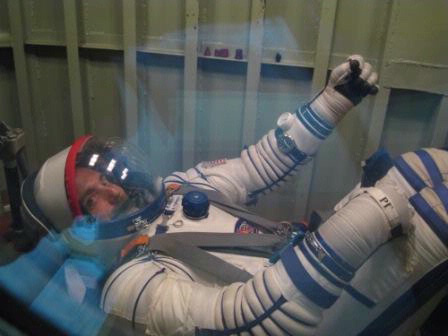Astronaut's Son Draws Insignia Inspiration from Parents, da Vinci

Like anysoon-to-be astronaut, Richard Garriott needed a patch to sew onto his spacesuitand to represent his mission. Unlike those who have launched before himhowever, Garriott had a unique source for his insignia's inspiration: his astronautfather.
"Myinspiration really came from my father's first flight on Skylab," said Garriottof his father, Owen, who 35 years ago this week lifted off for a 59-day stayon-board the first U.S. space station. Like his father, Richard Garriott isdestined for an orbiting outpost, the International Space Station (ISS), butnot as a NASA astronaut. A successful video game developer, he has paid about$30 million to fly asa spaceflight participant aboard a Russian Soyuz currently scheduled tolaunch on Oct. 12 of this year.
So when itcame time to follow the tradition of designing a patch, Garriott sawsimilarities between his mission goals and those pioneered by his father, aswas represented by the Skylab II crew emblem.
"Thereason I thought that [the Skylab II emblem] was a particularly suitable patchto use as a kind of a basis for mine was that it began with an image ofLeonardo da Vinci's 'Vitruvian Man'," Garriott told collectSPACE.com,referring to the renaissance artist's 15th century drawing depicting theproportion of a man. "That was selected for the Skylab patch for a numberof reasons, most notably because part of what they worked on Skylab was thestudy of human physiology."
"Furthermore,I actually designed this patch in cahoots with my mother, who is a professionalartist," continued Garriott. Unbeknownst to Owen until he arrived onorbit, an alternate version of the Skylab II patch also flew, this one listingthe names of the crewmen's wives — including Helen-Mary, Richard's mother —and altering da Vinci's "Vitruvian Man" to appear as a similarly-styledwoman.
Whether inthe original male or female form, da Vinci's art is well known for its blendingof science and art, a feature that underscored Garriott's interest in its use.
"I gotmy science and technology background from my father, my artistic inclinationsfrom my mother and if you think of the quintessential high tech art, I wouldsay that computer games fill that niche pretty darn well and so I really owe mycareer to both of my parents."
Get the Space.com Newsletter
Breaking space news, the latest updates on rocket launches, skywatching events and more!
"Plusthere is even another little echo," revealed Garriott. "Leonardo wasnot only a great artist but he was also a great scientist. So my parents,inspired by that, after they had invested in my first company Origin and afterwe sold it, they had public stock [and took] some of that money... and theywent back to their hometown of Enid, Oklahoma where they built Leonardo'sDiscovery Warehouse, which is a children's hands-on science and art facility.The main logo for [that center] is this same image of Leonardo's."
"So,this patch has a great deal of personal family history imbued in it forme."
Click here to see RichardGarriott's personal mission patch at collectSPACE.com.
Thesimilarities between Garriott's patch and his father's do not end with daVinci's drawing. Both share a planetary background.
"SkylabII included the Earth and in his case, the Sun, behind this image because theywere both doing earth sciences as well as solar research. While I am doing abunch of earth sciences, unfortunately I don't get a chance to do much solarresearch on the current ISS as it wasn't designed for that purpose," describedGarriott.
"In mycase, I also included the six flags for the nationalities of the six crewmembers I'll fly on-board the ISS with."
Garriott,whose name adorns the base of the patch, will launch with NASA astronaut MikeFincke and Russian cosmonaut Yuri Lonchakov. Once at the station, he will meetU.S. flight engineer Greg Chamitoff, Russian flight engineer Oleg Kononenko andcommander Sergei Volkov.
"'GenerationII' [at the bottom of the patch] is, of course, fairly obvious. It isreflecting that I am the first second generation American. I'll be flying withthe first second generation Russian, Sergei Volkov,and we'll return from space together."
Roundingout the symbolism on his patch is a small logo dividing Garriott's name from"Generation II".
"Andthis small symbol that you see between the two is something called a triscalion.It's like a little yin and yang symbol but with three parts. It is one of theprinciple symbols of my latest game, 'Tabula Rasa'," he described."And as Tabula Rasa has been a big part of my life here in preparation forthis flight, as it's a science fiction game about traveling through space, andI'm about to take my journey into space it seemed like an appropriate piece toinclude in this patch."
Garriottwill wear his patch on his Sokol pressure suit for his launch and landing,alongside a Soyuz TMA-13 crew patch that has yet to be designed. He will alsocarry with him patches made from the winningdesign of a student competition organized by the Challenger Center forSpace Education.
- Video: Dangerous Spacewalk: Handling Explosives
- Future of Flight: Space Tourism, Investment and Technology
- Complete Space Station Mission Coverage
Join our Space Forums to keep talking space on the latest missions, night sky and more! And if you have a news tip, correction or comment, let us know at: community@space.com.

Robert Pearlman is a space historian, journalist and the founder and editor of collectSPACE.com, a daily news publication and community devoted to space history with a particular focus on how and where space exploration intersects with pop culture. Pearlman is also a contributing writer for Space.com and co-author of "Space Stations: The Art, Science, and Reality of Working in Space” published by Smithsonian Books in 2018.In 2009, he was inducted into the U.S. Space Camp Hall of Fame in Huntsville, Alabama. In 2021, he was honored by the American Astronautical Society with the Ordway Award for Sustained Excellence in Spaceflight History. In 2023, the National Space Club Florida Committee recognized Pearlman with the Kolcum News and Communications Award for excellence in telling the space story along the Space Coast and throughout the world.









